Intel Core i7 4960X (Ivy Bridge E) Review
by Anand Lal Shimpi on September 3, 2013 4:10 AM EST- Posted in
- CPUs
- Intel
- Ivy Bridge
- Ivy Bridge-E
Video Transcoding
With our lightly threaded tests behind us, it's time to move to more CPU intensive pastures.
We migrated to the latest verison of the x264 HD benchmark which features a much newer version of x264 and a much heavier workload. The focus here is on quality rather than speed, thus the benchmark uses a 2-pass encode and reports the average frame rate in each pass.
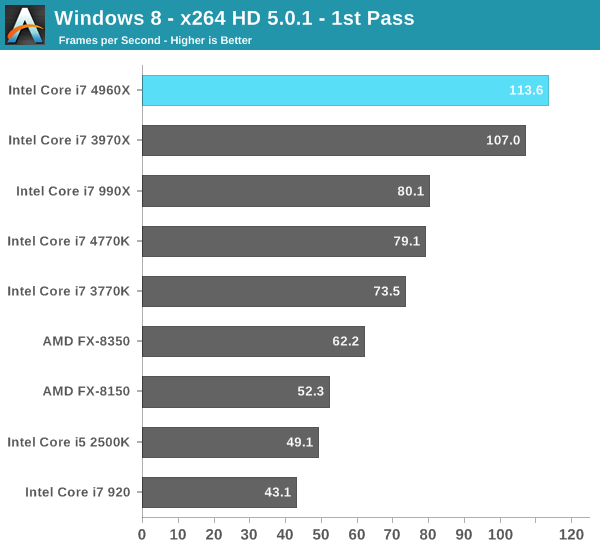

Here we see all of the 6-core parts rise to the top, including Intel's old Gulftown based Core i7-990X. Despite being a few years old at this point, the 990X's 6-core design and relatively high clock speed gives it better performance here than the quad-core Haswell 4770K.
The 4960X manages to be around 30% faster than the old 990X, and is 40% faster than the 4770K. For heavily threaded applications, there's simply no replacement for more cores.
Just like I did earlier, I dusted off one of our really old x264 tests so we'd have comparison data to even older CPUs including the Pentium 4 and Penryn based Extreme Edition parts:
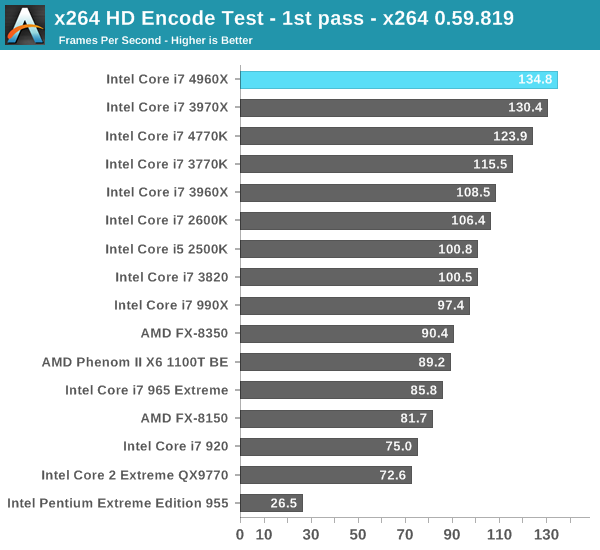
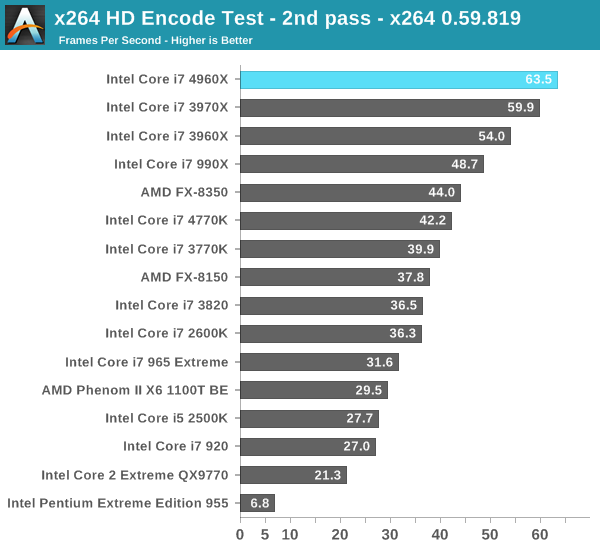
The 4960X manages to deliver nearly 3x the performance of Intel's flagship from 6 years ago. The Pentium EE 955 comparison is even more insane. IVB-E is basically an order of magnitude faster than the last high-end Pentium 4s to come out of Intel back in 2005.
3D Rendering
Our new POV-Ray benchmark uses the latest beta binary (3.7RC6) and runs through both single and multithreaded versions of the popular raytracing benchmark.
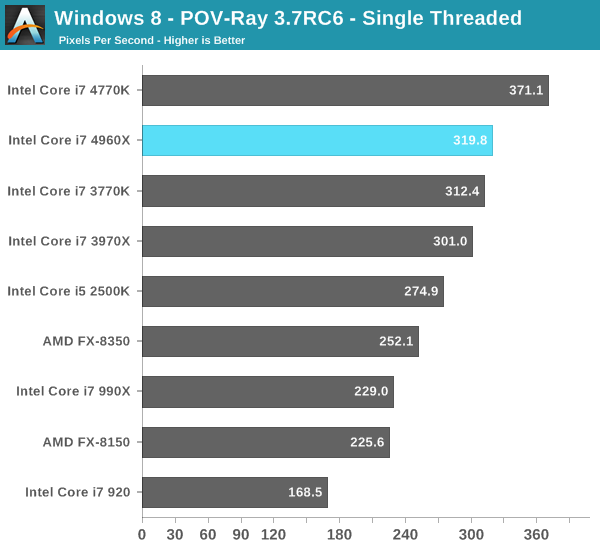
Isolating a single core shows us exactly what we're missing by having Ivy Bridge at the heart of the 4960X instead of Haswell. Here the 4770K manages a 16% performance advantage over the 4960X, which costs 3x as much and draws substantially more power. Looking at AMD's FX-8350 however it's clear why Intel can get away with launching a high-end 6-core chip without its latest cores. Piledriver's single threaded performance falls somewhere between Nehalem and Sandy Bridge, giving Intel room to launch another Ivy Bridge based high-end SKU in 2013 and get away with it.
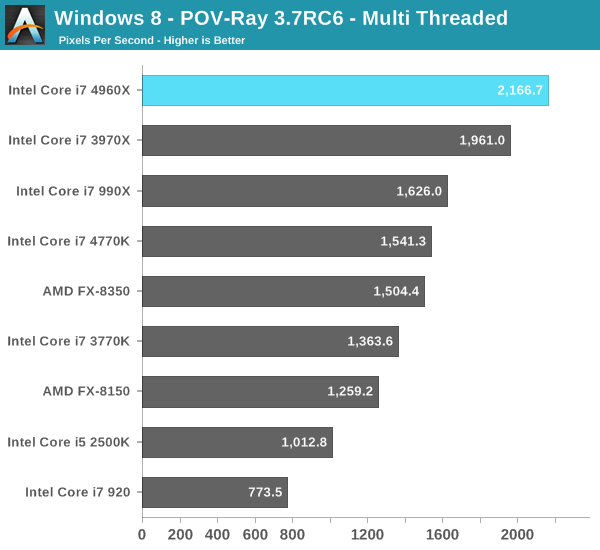
The multithreaded performance story is very different. Here even the Gulftown based 990X is faster than Haswell thanks to its six cores. The 4960X is 40% faster than the Haswell based 4770K. Even AMD's FX-8350 does really well here, basically equalling Haswell's performance.
Created by the Cinema 4D folks we have Cinebench, a popular 3D rendering benchmark that gives us both single and multi-threaded 3D rendering results.
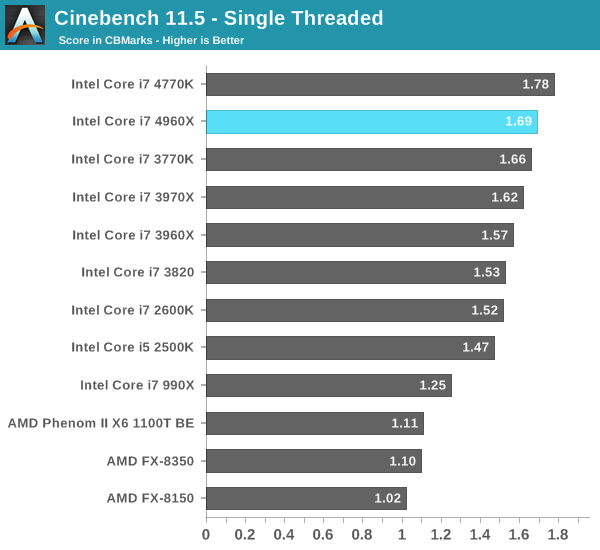
In Cinebench, the single threaded Haswell/IVB-E gap narrows to 5%.
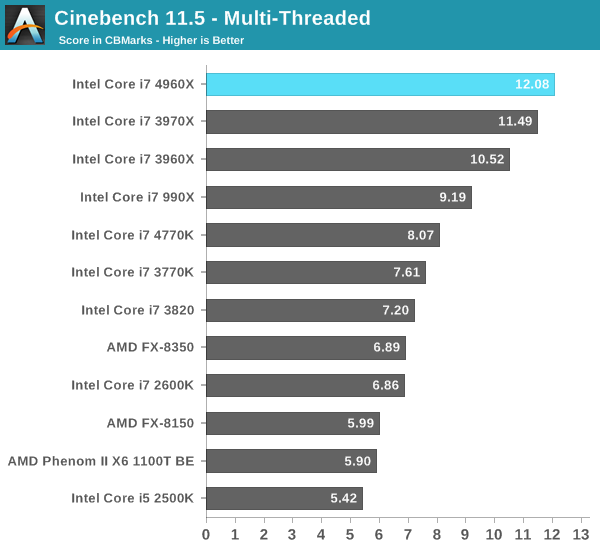
Multithreaded performance continues to be just stellar. Here the 4960X is just under 50% faster than the 4770K. Note the relatively small gap between the 4960X and the SNB-E based 3970X however - the performance gain is only 5%. The bulk of Ivy Bridge's advancements were in GPU performance (not applicable to IVB-E) and power consumption (which we'll get to shortly).
Our final two Cinebench tests use the R10 benchmark to enable a comparison to more/older data points:
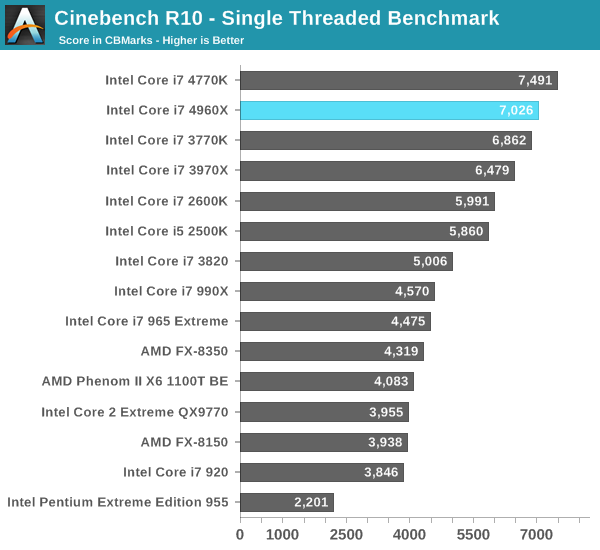
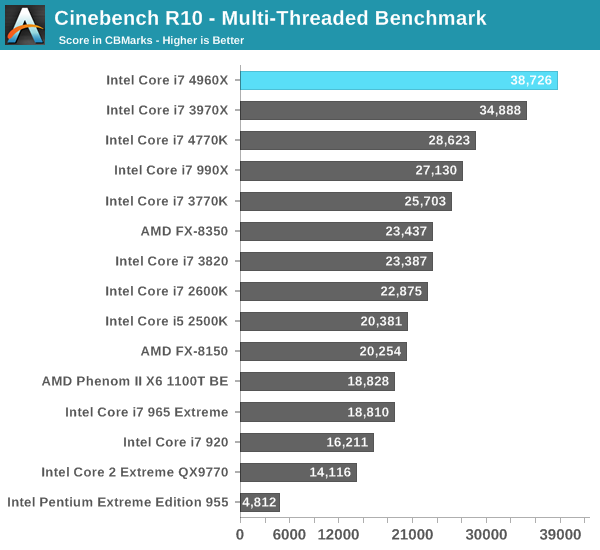










120 Comments
View All Comments
1Angelreloaded - Tuesday, September 3, 2013 - link
Can you have a comparison chart please for the 4770k, E5-8core Xenon, 4960X, with benchmarks included. This kind of makes little sense to me X-79 was behind on feature sets like full SATA3 when in reality a lot of these boards will be used as workstation/normal/gaming computers, performance on those boards tends to suffer because lack there of native support. Instead 3rd party chips are used to add extra features which have significant drawbacks. I understand using the socket for 2 gen in order to extend life of boards however 1336 and the next leap to haswell should have been taken, making a board last 2 years with the prime features that defined that generation. This just seams like intel is ignoring its higher end market due to lack of competition out there.sabarjp - Tuesday, September 3, 2013 - link
Kind of depressing that 3 years of technology only took the compile of Firefox from 23 minutes to 20 minutes. The high-end isn't looking so high these days.dgingeri - Tuesday, September 3, 2013 - link
So where's the 4820k review? I don't care much about more than 4 cores, but I need more I/O than Haswell offers. (crappy motherboards that offer either 8/4/4 or 8/8/2 are just unacceptable.) I'd like to know how the 4820k overclocks and handles I/O from dual and triple SLi/Crossfire.Eidigean - Tuesday, September 3, 2013 - link
Visual Studio unfortunately does not compile in parallel the way you might think. In a solution you may have multiple projects. If one project depends on four other projects, those four will be compiled in parallel; one project per thread. Once the four dependencies are built, it can build the fifth; however, that last project will be built single-threaded.Xcode and native Android projects (with gcc) can actually build multiple files from one project in parallel. On an i7 with hyperthreading, all eight logical processors can build up to eight files simultaneously. This scales with more cores very nicely.
In summary, VS builds multiple projects from one solution in parallel, while gcc builds multiple files from one project in parallel; the latter of which is much faster.
I'm curious now to see the build times of Firefox for Mac on a rMBP with an i7. Eagerly waiting for a 12 core Mac Pro with 24 logical processors.
BrightCandle - Tuesday, September 3, 2013 - link
Visual Studio is a very poor parallel compilation test. GCC with make -p can really utilise a lot more cores but its not very Windows like to use GCC (although I suspect many developers do that).I haven't found many Java builds doing well on multiple cores, and neither Scala. Its the unit tests where I get the cores going, I can saturate hundreds of cores with unit tests if I had them, and since I run them in the background on every change I certainly do get a lot of usage out of the extra cores. But a clean compile is not one of those cases where I see any benefit from the 6 cores. Of course I would hope these days we don't do that very often.
althaz - Tuesday, September 3, 2013 - link
It is a poor parallel test, but it is a fantastic real-world test for a lot of devs.madmilk - Tuesday, September 3, 2013 - link
About 25 minutes here on an 2.6GHz/16GB rMBP. Pretty much as expected for quad Ivy Bridge.bminor13 - Tuesday, September 3, 2013 - link
Parallel file-level compilation is possible in VS2010 and up with the /MP project switch. This is not enabled by default I believe for compatibility reasons.BSMonitor - Tuesday, September 3, 2013 - link
A Haswell-E will most likely bring a different pin-count, correct?? So this X79 is a dead end platform any way you look at it. Buying the Quad IVB-E makes almost no sense whatsoever.Casper42 - Tuesday, September 3, 2013 - link
Most Intel chips use a Tick Tock release cycle. Tick Tock Tick Tock Tick Tock etcTick is an Incremental upgrade. Same socket and largely same design, but reduced lithography (32nm down to 22nm for example). Sometimes new Instructions but often not.
Tock is an Overhaul upgrade. Uses same Lithography as the previous gen, but is a new internal architecture, often a new Socket, and where most new Instruction sets show up.
Then you get another Tick.
Core 2/Conroe was a Tock and was 65nm
Core 2/Penryn was a Tick and was 45nm
Core iX/Nehalem was a Tock and was 45nm
Core iX/Westmere was a Tick and was 32nm
Core iX/Sandy Br was a Tock and was 32nm
Core iX/Ivy Bridge is a Tick and is 22nm
Core iX/Haswell is a Tock and is 22nm
So to say that X79 is a dead platform should not really be a shock to anyone. They got Sandy and Ivy out of it. Thats 1 Tock and 1 Tick and now its time to move on. They do this exact same thing in the 2P Server market where people spend $10K or more per server. The fact of the matter is the server market has already pretty much learned. Don't bother upgrading that server/machine, just ride it for 3-4 years and then replace it completely. SATA, Memory and CPUs have all changed enough by then you want to reset everything anyway.